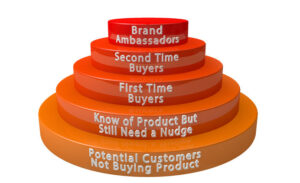
When a customer purchases a product or service from a company, the nature of the relationship changes. While it is not the beginning of a relationship, all the hard work a salesperson did to get the business needs to be redirected in order to retain it. Ideally, the relationship will become more symbiotic, as the salesperson and others who interact with the customer continually earn the trust and respect of the buyer. This is the beginning of the process to build brand ambassadors.
In addition to any face-to-face interactions, relationships are maintained through the proactive efforts of the customer service team, which are facilitated by marketing, communications and public relations initiatives. It is the commitment to and delivery of the brand promise that keeps customers loyal and happy. When this happens, customers become “brand ambassadors” who can provide referrals, sing the seller’s praises and make future sales easier. With 91% of B2B buyers influenced by word-of-mouth when making buying decisions, resourceful and cultivated brand ambassadors are important assets for companies to develop.
Focus on Success

Marketing efforts that focus on client successes help to humanize a company and its brand. The first skill a brand ambassador needs to have is a sincere interest in others along with the ability to listen—really listen so someone else feels heard. Secondly, because of a brand ambassador’s great customer experience with the company, they speak from first-hand knowledge. They are believable and authentic. They are satisfied with the service and product, understand its value and positive impact, and place complete trust in the buyer’s organization.
The role of brand ambassadors varies, but here are some tangible ways brand ambassadors advocate for the company. They perform the following roles:
- Contribute to user-generated review sites
- Provide case studies and customer success stories
- Deliver text or video client testimonials
- Refer potential customers
- Endorse companies via social media
- Share thought-leadership through appropriate channels
Strategy For Developing Brand Ambassadors
While brand ambassadors can be handpicked or cultivated, developing external brand ambassadors needs to be an active component of any marketing strategy. Here are some ways to make it happen:
- Set your objectives. Understand what you want your ambassadors to achieve. Do you seek increased lead generation? Customer retention? Social media exposure? Certain mediums and distribution are better suited for some goals than others. These objectives should be measurable with an accompanying timeframe to achieve them. Define available resources, and make sure your goals don’t exceed your resources.
- Don’t wait for ambassadors to find you. Analyze your customer database to identify those who are most likely to become brand ambassadors. Gather input from others. Look for positive results and human-interest stories from people who, not already love your brand and mesh well with your company message, but also have the potential to broaden your audience.
- Provide support. If you seek to publish a case study or client success story, its production is your responsibility. Provide ample support, structure and encouragement when conducting research or requesting testimonial content. Equip brand ambassadors with the tools, access and ease of communication to provide and share content.
- Show appreciation. Client appreciation is important, but those who take the extra step to serve as brand ambassadors go the extra mile. There are many ways to show gratitude. You can give them access to exclusive previews, trials, content or an ambassador-only rewards programs. You can also simply send a personalized gift or handwritten note. However you choose to show it, ensure your ambassadors know you appreciate their contributions.
Highlight the Human Element

When it comes to the most important buying decisions, consumers first look to others they trust—friends, colleagues or other reputable resources. B2B purchase decisions are no different. By creating a network of knowledgeable and satisfied brand ambassadors, companies use the most powerful resource they have—the human touch—to reinforce their viability as the seller of choice.

